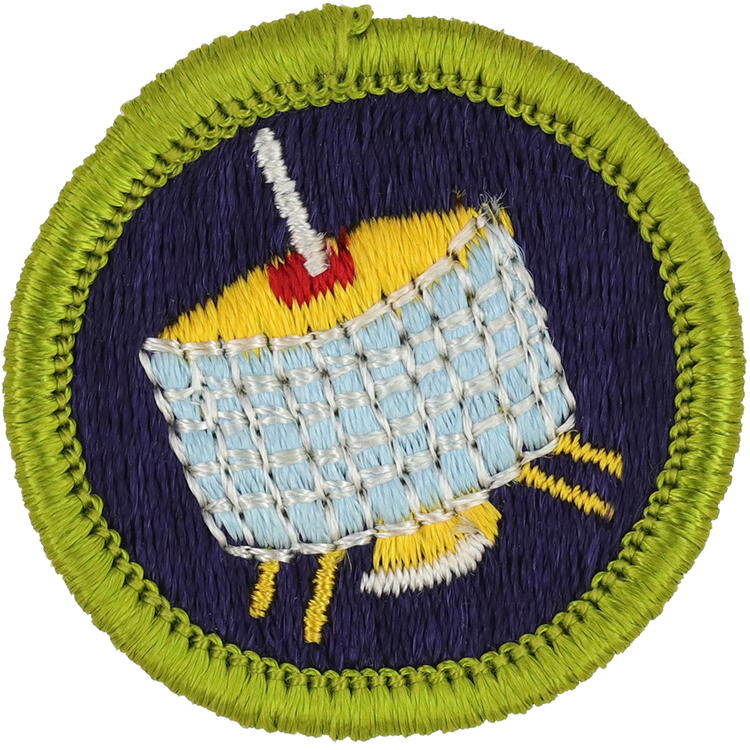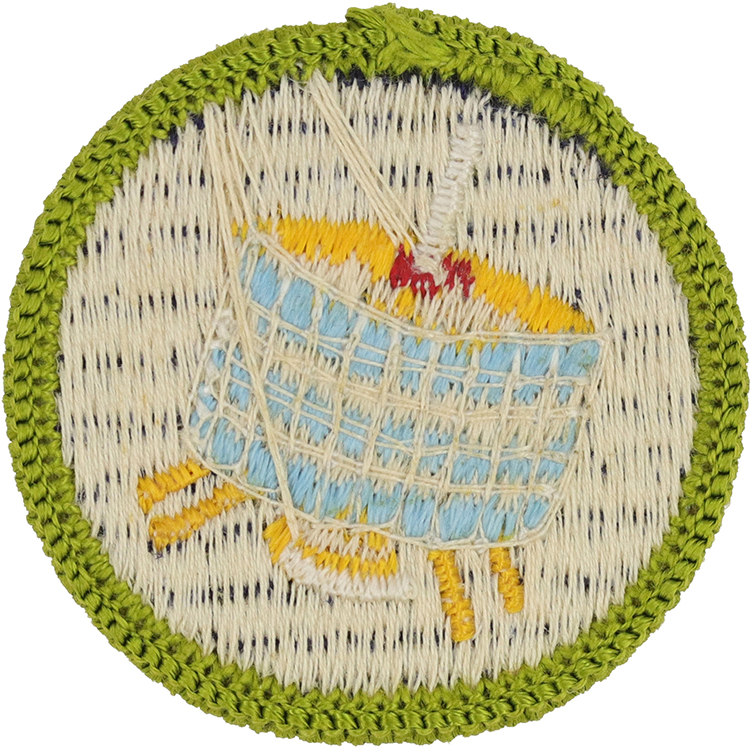
Fig. 1: Commun-G-Front
- Embroidery: Cotton thread
- Border: Merrowed

Fig. 2: Commun-G-Reverse
- Back: Starched cloth
Item Name: Communications 1965 - 1972
Item ID: Commun-G
Collector Rating: 1
Requirements November 1965 until December 1966
1. Earn the Gold Quill Award*
OR
Write in three hundred words or less why you think the ability to communicate with others is important. Include in your statement your answer to the following:
(a) Why should you improve your ability (1) to put your ideas into words, (2) to make your ideas understandable, and (3) to understand what other people are saying to you?
(b) By what different means can you communicate with others?
2. Complete four of the following:
(a) Still photography.
(1) Show how to crop a picture in order to emphasize a particular detail.
(2) Take a series of six photographs showing how to perform a mechanical process, like the assembly of a model plane wing, tent-pitching, or know-tying. Mount them attractively in proper order with suitable captions. Explain how this picture series has a subject, verb, and object, like a sentence.
(b) Printing - Make a layout or a paste-up of a printed page that will deliver one idea to the reader. This may describe a show, an item for sale, or a meeting you want the reader to attend.
(c) Journalism - Write an article of no more than three hundred words suitable for publication in a newspaper. For example, tell the story of a Scouting activity.
(d) Moving pictures - Take a moving picture 5 minutes long showing a complete process, for example, knife-sharpening. Present a smoothly run projection of your film.
(e) Slide pictures - Make a set of 20 slides or a slide film showing a complete process. Present a smoothly run projection of your slides or film.
(f) Radio-TV - Write and narrate a 1-minute commercial describing an imaginary product so as to convey one idea about it.
(g) Graphic demonstration - Make a flannel board and show how it can be used to get across an idea. For example, you might present a method for organizing your patrol. Make and demonstrate a flip chart and flash cards for the same purpose.
(h) Sign writing - Using a blackboard and cutout cardboard letters that you have made as templates, show the size-distance scale that determines legibility, and show how legibility is improved by neatness and contrast.
(i) Transparencies - Using transparent plastic sheets and wax pencils, make a series of 10 slides for vu-graph or overhead projector to illustrate a talk on how to use a map and compass. Project your slides and narrate your message.
(j) Memorandums - Plan a unit activity involving at least 10 people. Write a memorandum to each, explaining his part in a smooth running activity. Make a carbon copy of each memorandum.
(k) Duplicating - Prepare for duplication a bulletin or meeting notice conveying one ides to the readers (for example, Vote on Election Day). Obtain permission, and make five copies of this bulletin under proper supervision.
3. Write a one-page letter to a businessman requesting a specific position in his firm, and telling him why you are qualified for it.
4. Demonstrate how you would make a telephone call inviting an expert fisherman who is a friend of your unit leader to give a demonstration on fishing to your unit.
5. Public speaking:
(a) Write a 5-minute speech and deliver it at your unit meeting.
(b) Demonstrate how to introduce a guest speaker to your unit.
Requirements December 1966 until June 1972
1. Earn the "Gold Quill" Award
OR
Write in 300 words or more why you think the ability to communicate with others is important. Include in your statement your answers to the following:
(a) Why should you improve your ability to put ideas into words and to make other people understand you?
(b) What different ways are available for you to communicate with others?
2. Complete ONE from each of the following four groups:
GROUP A - Tell what part publicity and public relations play in American life today.
(1) Journalism and Newspaper Publicity - Write an article of 300 words or more and have it published in a newspaper or bulletin.
Example: Tell a story of a Scouting activity that would interest people, who are not in Scouting, in joining as Scouts or Scout leaders.
(2) Public Relations - Write 300 words or list in an outline at least six things you would propose doing to meet some public relations problem of your troop.
Example: How to show the people of your community that Scouting generally and Scouts individually do many things to help others and perform useful services for the local people
GROUP B - Tell what part advertising plays in American life today.
(1) Advertising Layout - Make a layout or "pasteup" of a printed page - for instance, a one-page advertisement that will deliver one idea to the reader. This may describe a show, an item for sale, or a Scout project or activity you want people to attend.
(2) Radio-TV Advertising - Write and record on tape a 1-minute spot announcement or commercial describing a Scouting project or an imaginary product so as to convey one idea about it.
GROUP C - Tell how photography is used in communications.
(1) Still Photography.
(a) Take a series of six photographs showing how to perform a mechanical process, like assembling a model plane wing, pitching a tent, or tying a know. Mount them attractively in proper order with suitable captions. Explain how this picture series has a subject, verb, and object like a sentence. Describe a "picture paragraph".
(b) Show how to "crop" a picture showing a particular detail.
(2) Moving Pictures - Make a moving picture of 5-minutes duration showing a complete process. Demonstrate smooth projection of films.
Examples: How to sharpen a knife; pitching a tent.
(3) Slide Pictures - Take a set of 10 or more slides for the same purpose. Demonstrate smooth projection of slides.
Examples: How to sharpen a knife; pitching a tent.
GROUP D - Explain how other methods of communications are used.
(1) Graphic Demonstration - Make a flannel board and show how it can be used to get across an idea. Make and demonstrate a flip chart and flash cards for the same purpose.
Examples: How to organize your patrol; the benefits of attending summer camp.
(2) Transparencies - Using transparent plastic sheets and wax pencils, make a series of 10 slides for vu-graph or overhead projector to illustrate a talk explaining how to use a map and compass. Project your slides and narrate your message.
(3) Sign Writing - Using a blackboard and cutout cardboard "template" letters that you have made, demonstrate the importance of legibility in signs, blackboard writing, and printing. Show the size-distance scale that determines legibility and show how neatness and contrast improve it.
(4) Memorandums - Plan a unit activity involving at least 10 people. Write a memorandum to each, explaining his part for a smooth running activity. Make a carbon copy of each memorandum.
Example: Assignment of jobs at a Scout physical fitness rally.
(5) Printing and Duplicating - Prepare for duplication a bulletin or meeting notice conveying one idea to the readers. Obtain permission and make 25 copies of this bulletin under proper supervision.
Example: Vote on Election Day.
3. Letterwriting - Write a one-page letter that you would send to a man requesting a specific position in his firm, telling him why you are qualified for it.
4. Telephone - Demonstrate how you would make a telephone call inviting a friend of your unit leader who is an expert fisherman to give a demonstration on fishing to your unit.
5. Public speaking - Do the following:
(a) Write a 5-minute speech and deliver it at your unit meeting, for instance, a talk on the role of communication in modern life in your community or a talk on what advertising and public relations could do to help local people know more of the benefits of Scouting.
(b) Demonstrate how to introduce a guest speaker to your unit.
The following are the requirements for the Gold Quill Award for the time period November 1965 until June 1972.
The Gold Quill Award is presented in recognition of your ability to express yourself clearly. Fulfillment of its requirements gives you credit toward your Communications merit badge. Your unit leader will supply you with a Gold Quill scoreboard-application form and will present you with your award when you have completed the following:
1. Write in 300 words or less why you thank the ability to communicate with others is important. Include in your statement your answer to the following:
(a) Why should you improve your ability -(1) To put your ideas into words. (2) To make your ideas understandable. (3) To understand what other people are saying to your?
(b) By what different means can you communicate with others?
2. Do ONE of the following five projects:
(a) Submit a published article that you have written.
(b) Submit a photograph you have taken that has been published in some form. Include a 25-word description of the photograph's subject.
(c) Submit evidence that you have made a verbal report before your church or synagogue, club, or similar group.
(d) Serve on the production staff or as an accredited reporter for your unit, district, or council newspaper, or for the newspaper of a national special even, such as the jamboree or the Explorer delegate conference.
(e) Submit material or evidence to show your unit leader that you have prepared a message and communicated it to others. This might include a scrapbook of unit activities, a history of your unit, a play, or the script of a ceremony.
3. Visit a radio station, a television station, a recording studio, a photography studio, or a newspaper office and observe its operation so that you can explain it to your unit leader.
4. Discuss with your unit leader the requirements for the Communications merit badge.

